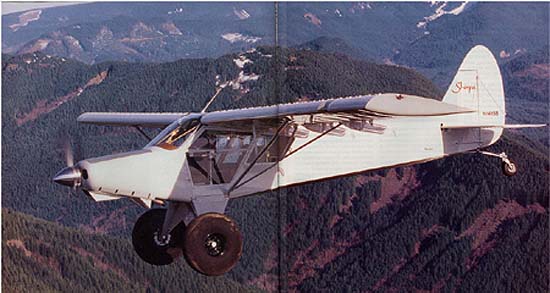
Sherpa

PAGE FOUR Sherpa Tech Specs Structurally the Sherpa is a rag and tube fuselage and metal wings (airfoil 43015A Modified) with 120 gallon (to be increased to 180 gallon!) fuel tanks. But this is a serious tube fuselage...the longerons, for instance, top and bottom are 1 1/4 "x .058". Everything about the airplane is built tough to take a beating. The landing gear, besides being massive, utilizes a shock absorber along with the bungees to dampen rebound. This shock is not an air/oil oleo because that wouldn't let the gear come back to rest quickly enough after hitting a rock. The gear might still be partial extended when it hit the next one. The Sherpa shock uses urethane washers which have a more immediate response. The elevator trim is electric utilizing dual screw jacks and the flap motor looks big enough to move a house. It takes about 9 seconds for extension and ten to retract them. The Lycoming IO-720 engine is an enigma to most of us because most of our knowledge of it comes from its use in the Commache 400. There it had a less than enviable reputation largely because it was tightly cowled and prone to over heating. The Sherpa team has utilized the experience of numerous Piper Brave ag operators in the area which swear by the engine. They say they go to 2,000 hr TBO will few problems. While we were flying the airplane, in ten hot-starts, it never hesitated. They have gone through a number of propellers and have yet to finalize the selection. The four-blade they had on the airplane during our evaluation wasn't putting out as much thrust as their earlier Hartzell three-blade had. Some foreign governments have expressed an interest in a turbine installation, but no one at Sherpa is wild about the idea. Besides doubling the cost of the airplane, they say its not going to improve its performance enough to justify the cost except possibly on floats. The tires can be either the standard 29 inch, aircraft versions or the baloney skin tundra tires like we flew. Those are actually four-wheel truck tires with the tread ground off mounted on 15 inch aluminum, one-ton Chevy truck rims. They say they have been flying that type of tire for nearly 15 years with little or no problems. The brakes are two, three-spot calipers on each wheel. The tailwheel is a standard 500 x 5 main gear unit and the tailwheel assembly is something that is undergoing continual revision. Because of the airplane's weight and the surfaces they intend to work off of, nothing commercial has stood up so they've left a lot of tailwheels up in the canyons. Presently they are testing their own assembly which utilizes a CNC'd 7075 pivot with a 4130 weldment fork. The airplane is currently configured for a 1-2-2 seating arrangement but the seats are actually wide enough for three across in a tight squeeze. The single front seat will be changed to a side by side arrangement for those who want it along with a sliding, side opening door in the rear of the fuselage for passengers, cargo or litter cases. Knowing what little I know about bush flying at this point, I'd rather have the single pilot seat so both sides of the nose are visible on landing. The floors are a honeycomb sandwich and production airplanes will have a multi-use track system which would allow easy removal or repositioning of seats as well as cargo tie down. The cargo space aft of the pilot's seat will accept the equivalent of five 55 gallon drums. Useful load is just short of 2,200 pounds! It's some kind of hoss! For lots more pilot reports like this one go to PILOT REPORTS Sherpa Aircraft Mgf. Co. Wing Span 42.6' (present wing) Performance |